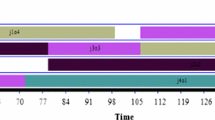Abstract
The interior of superyachts is either designed by an expert or modeled on previous layouts that have been successfully designed. Changing one arrangement to the other is challenging and has not been tried without the buyer’s request, mostly dissuaded by the current manual design procedure. In this work, an approach to determine the interior space arrangement is introduced. Space arrangement is performed by considering various design constraints that are expressed in terms of numerical values such as space occupation, shapes of spaces, and distance of stairs connecting relevant spaces, and a combination of those. The genetic algorithm is adopted to yield the space arrangement formulated as an optimization problem containing multiple objectives. The solution to the space arrangement problem has proven that the designer is able to generate a specific result due to the degree of freedom allowed by the formulation. The proposed design approach has led to efficient layouts for general arrangement of mid-sized superyachts. These possible candidates help the designer to choose a right arrangement based on his or her design concept or intention, which will make the interior arrangement task much easier and faster.



















Similar content being viewed by others
References
BIM (2011) Boat International Magazine. http://www.boatinternational.com
Nam J, Hyun B, Kim T, Kim D (2007) Analysis of hydrodynamic performance and establishment of modeling technique for determination of preliminary hull form of superyachts. J Soc Naval Archit Korea 44(4):451–458 (in Korean)
Lee H, Byun L (2007) A study on space arrangement and interior space division of superyachts. J Korean Inst Inter Design 6(2):224–231 (in Korean)
Nam J, Kim D, Lee H (2010) An approach to computerized preliminary design procedure of mid-size superyachts from hull modeling to interior space arrangement. J Naval Archit Ocean Eng 2:94–101
Lee K, Roh M, Jeong H (2005) An improved genetic algorithm for multi-floor facility layout problems having inner structure walls and passages. Comput Oper Res 32:879–899
Parsons M, Chung H, Nick E, Daniels A, Liu S, Patel J (2008) Intelligent ship arrangements: a new approach to general arrangement. Naval Eng J 120(3):51–65
Daniels A, Tahmasbi F, Singer D (2010) Intelligent ship arrangement passage variable lattice network studies and results. Naval Eng J 122(2):107–119
Goldberg D (1989) Genetic algorithm in search, optimization, and machine learning. Addison-Wesley, Reading
Chiu C, Hsu P (2005) A constraint-based genetic algorithm approach for mining classification rules. IEEE Trans Syst Man Cybern 35:205–220
Whitley D, Kauth J (1988) GENITOR: a different genetic algorithm. In: Proceedings of the Rocky Mountain conference on artificial intelligence. pp 118–130
Le T, Kim D (2011) Application of a real-coded genetic algorithm for the fitting of a ship hull surface through a single non-uniform B-spline surface. J Mar Sci Technol 16:226–239
Srinivas M, Patnaik L (1994) Adaptive probabilities of crossover and mutation in genetic algorithm. IEEE Trans Syst Man Cybern 24(4):656–667
Acknowledgments
The part of this work was sponsored by the Ministry of Knowledge and Economy, Korea, through the Industrial Strategic Technology Development Program as well as by the National Research Foundation of Korea. Their support is greatly appreciated.
Author information
Authors and Affiliations
Corresponding author
About this article
Cite this article
Nam, JH., Le, TH. Automatic interior space arrangement of mid-sized superyachts using a constraint-based genetic algorithm. J Mar Sci Technol 17, 481–492 (2012). https://doi.org/10.1007/s00773-012-0182-1
Received:
Accepted:
Published:
Issue Date:
DOI: https://doi.org/10.1007/s00773-012-0182-1




